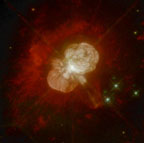
|
Eta Carina is the most luminous star in the galaxy. It has ejected huge amounts of material during the last few centuries, forming the nebula seen in this Hubble Space Telescope image. It also seems to have a more steady wind, and should become quite a spectacular supernovae in the not-too-distant future. |
The enormous amount of light given off by hot, massive stars can actually drive the material on the surfaces of these stars to incredible velocities (up to 3000 km/s or more; 100 times the local sound speed and 1% the speed of light). These radiation-driven stellar winds are an important source of energy and momentum in the galaxy's interstellar medium. And along with the supernovae explosions that end the lives of massive stars, hot star winds help to recycle material processed in the interiors of stars back into the interstellar medium where it is incorporated into the next generation of stars and, perhaps, planets.

|
This wind-blown bubble in the interstellar medium has been shaped by the outflow from a massive star near its its center. The ultraviolet light from the same star causes the nebula to glow. |
In addition to these important implications for the evolution of the galaxy, the winds of hot stars involve some interesting physics in their own right.
The solar wind and the winds of other "cool" stars (the sun has a surface temperature of "only" about 6000 degrees Kelvin, while hot stars range from 15,000 K to 50,000 K) are accelerated by the deposition of heat near the stellar surface; the solar wind is driven by temperature gradients and associated pressure gradients due to the heat supplied by the solar corona. Hot star winds are driven by a completely different mechanism. The star's enormous luminosity actually pushes on the stellar wind, transferring momentum directly from the star's light to its wind, with no associated heating.
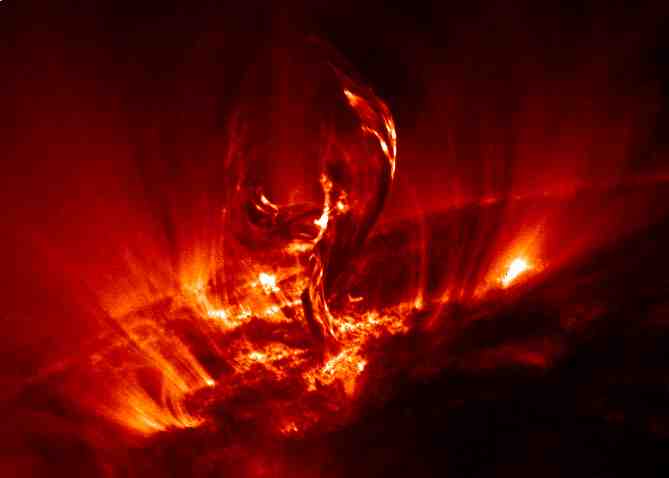
|
This image of the sun's surface was taken by the TRACE satellite (sites
here and here, with
fantastic pictures
here). The distribution
of the hot gas shown here reflects the magnetic field structure on this region of the sun.
The sun's magnetic field not only affects the distribution of the gas, but also is instrumental
in heating the gas, some of which can be seen to be ejected from the surface of the sun here.
Hot stars are thought not to have surface magnetic fields like this, but recently there's been some evidence uncovered that in at least some hot stars magnetic fields may exist and be important, for example in tau Scorpii and beta Cephei. |
Light has momentum, just like any other moving object (think of photons as little particles of light--they don't have mass but they do have energy). Just as for matter, the momentum of light is proportional to its energy divided by its velocity. So photons are an inefficient carrier of momentum for a given amount of energy, since their velocities have the highest possible value. However they do carry some momentum, and when a photon is absorbed or scattered by matter, it imparts not only its energy to that matter, but also its momentum. Remember, while energy is a scalar quantity, momentum is a vector quantity. Almost all the star light is coming from the same direction, so it tends to push the wind outward.
The sun's light carries much more momentum than does the solar wind (by about a factor of 10,000). However, the solar wind is not driven by radiation pressure. This is because the solar wind does not have significant opacity at those wavelengths where most of the sun's light is. The sunlight simply streams through the wind material, not interacting very much and taking its momentum away with it.
There is a minimum radiation force on any stellar plasma which is that due to scattering radiation off of free electrons. This force is frequency independent, and if the force of radiation pressure on free electrons in a star exceeds gravity (a limit referred to as the Eddington limit), the surface of a star cannot remain bound and the star would basically blow itself apart.
...but a stellar wind is not this, rather it is a steady loss of material from a star that is otherwise stable.
A hot star wind does not rely on free electrons to absorb the momentum from the star's radiation field. Instead, it uses electrons bound in atoms to absorb the radiation: Radiation pressure is transferred to the wind material via spectral lines. This has two important consequences that contrast with electron scattering:
1. the radiation force can exceed gravity with much lower flux levels because bound electrons provide much more opacity than do free electrons (see Ken Gayley's paper on the Q-factor approach to calculating the line-force in hot star winds, in which he discusses line opacity in terms of the high quality of the resonance between photons and bound electrons); and
2. as the wind is accelerated, the line profiles absorbing the radiation become broader due to the doppler shift, which desaturates optically thick lines, generating more overall opacity. In this way, a line-driven stellar wind bootstraps its own acceleration.
Hot star winds, unlike the solar wind, have plenty of line opacity in the ultraviolet where most of the photospheric radiation is. This good matching between the radiation and the opacity allows for the efficient driving of winds in hot stars by radiation pressure. And the stronger ultraviolet lines of hot stars show direct evidence for wind acceleration: P Cygni profiles, which are blue shifted absorption features in spectral lines (from the column of gas in front of the stellar disk that is moving toward the observer) accompanied by red shifted emission features (from the scattering of radiation off of fast moving wind material on the sides and back of the wind). Here's an example of a P Cygni line profile and a cartoon demonstrating how these features get their distinctive shapes (taken from Lamers and Cassinelli's textbook):
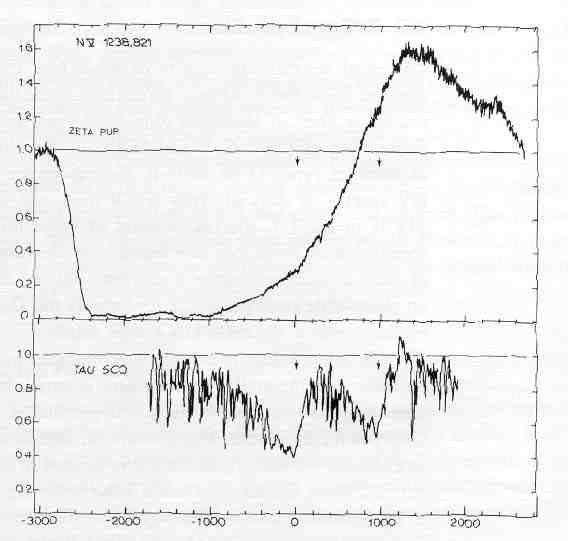
|
The wind-broadened N V (nitrogen in the fifth ionization state--with four electrons missing) doublet. The rest-wavelengths are indicated by the arrows. In the O supergiant zeta Pup (top) the doublets blend together as the very dense and fast wind leads to a broad P Cygni profile. Note that the wind has a velocity of about 2700 km/s, as determined by the blue edge of the absorption component. The less hot B main sequence star tau Sco is shown on the bottom. Its wind (at least in the N V ion) is only 1000 km/s. |
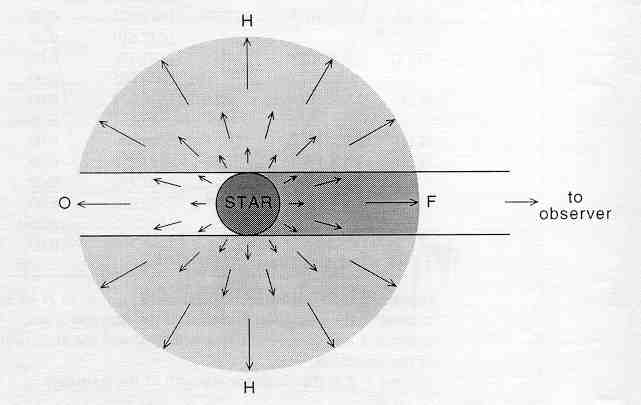
|
The formation of P Cygni profiles in an expanding stellar wind can be understood if we consider three regions of the wind: The tube in front of the star (F), the occulted region in the back of the star (O), and the sides of the wind, or the halo (H). |

|
The star's light provides continuum radiation (flat in frequency, or wavelength, or velocity). Region F leads to absorption, indicated in the top panel, region H to emission, indicated in the middle panel, and the bottem panel shows the total line profile, which is just the sum of the first two. |
Over the past 25 years, a very successful theory of steady-state radiation-driven hot star
winds has been constructed. The seminal work was by Castor, Abbott, & Klein
in 1975 (but see
Ken Gayley's Q-bar paper
for a clearer and, I believe, more fundamental
framework for understanding the line force in winds and the steady-state wind solutions). These models have been progressively
refined, including effects like the finite cone angle (the photospheric radiation
becomes more forward-peaked the farther the wind gets from the star), culminating
with the very detailed, non-LTE wind models calculated by the Munich group, led by
Kudritzki, Puls, and Pauldrach (note that to correctly calculate the line force in the wind,
tens of thousands to hundreds of thousands of atomic transitions of numerous elements have
to be included). Castor, Abbott, and Klein's great insight was realizing that this huge number of lines could be
successfully treated statistically as a power law distribution of line-strengths.
The Munich group has calculated detailed line-strength distributions
in order to find the power law slope and normalization for a wide range of different stars.
These models do an excellent job of reproducing the time average properties of hot star winds.
However, hot star winds are not in steady state. Here are some line profile time-series of hot star winds.
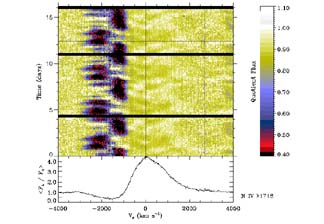
|
A color-coded line profile (intensity as a function of wavelenght, or velocity, along the x-axis) is shown versus time (on the y-axis) for the Wolf-Rayet star HD 50896. Recurrent absorption enhancements can be seen propagating through the wind from low velocites to high velocities. The mean profile (to which the time-series color profiles are ratioed) is shown along the bottom of the figure. |
Fluctuations that appear random in the line-profiles of hot star winds, as well as these large-scale, coherent, and periodically variable profiles are seen in UV and optical spectra. One can only conclude that the radiation-driven winds of hot stars are variable on time scales and spatial scales both large and small.
More hot star wind information, with an emphasis on my areas of current hot star
research.